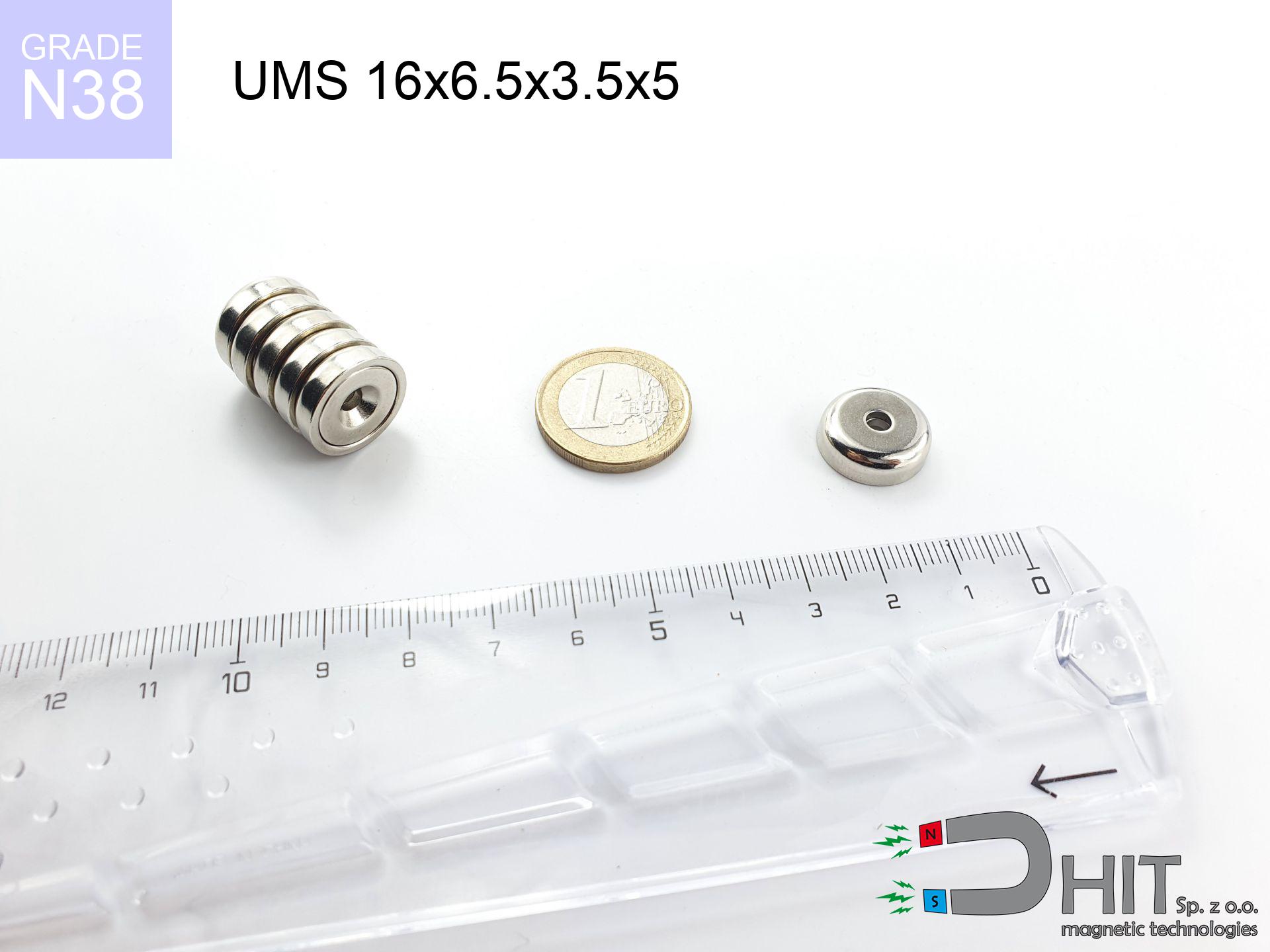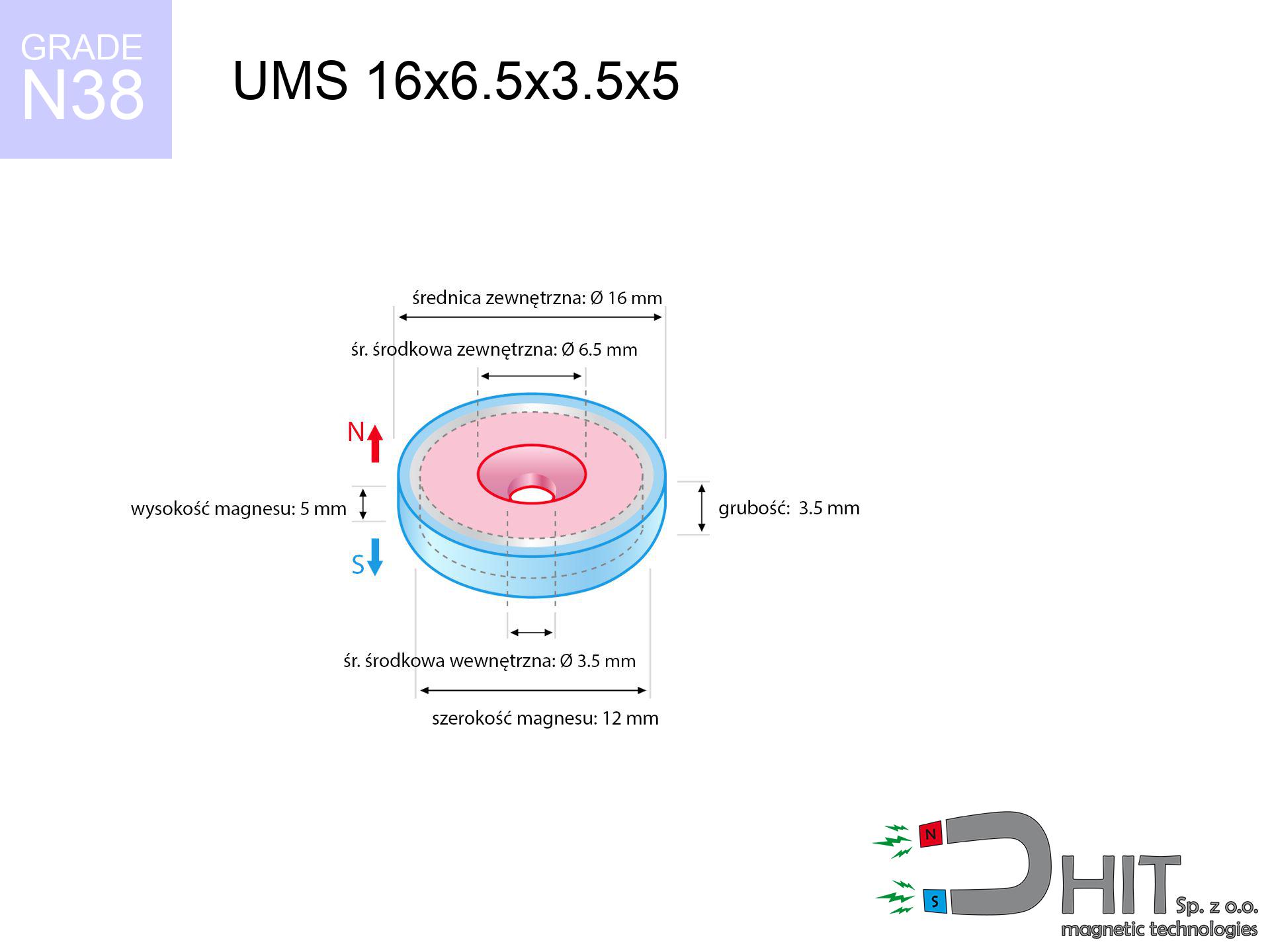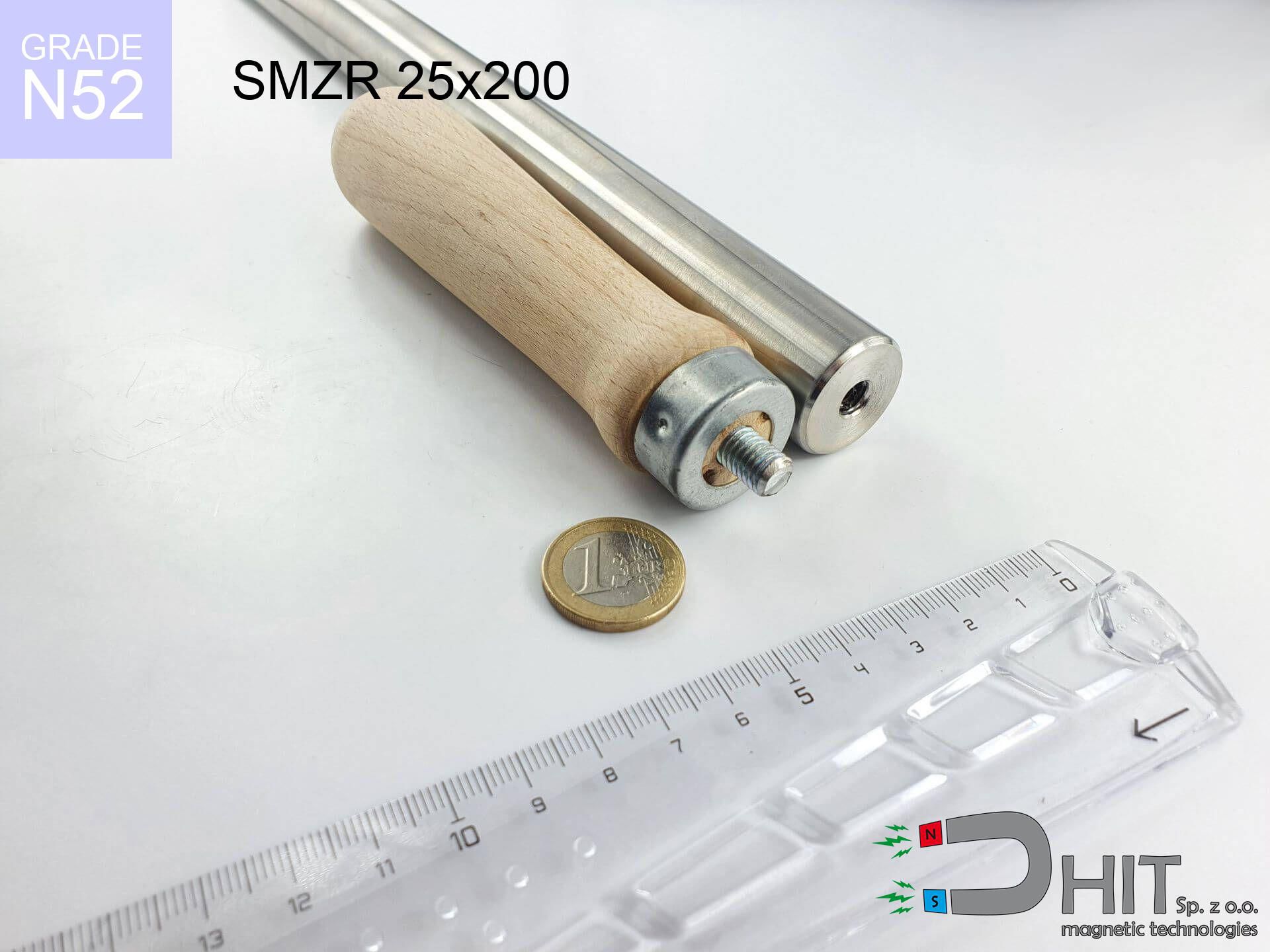UMS 16x6.5x3.5x5 / N38 - conical magnetic holder
conical magnetic holder
Catalog no 220326
GTIN/EAN: 5906301814160
Diameter Ø
16 mm [±1 mm]
cone dimension Ø
6.5x3.5 mm [±1 mm]
Height
5 mm [±1 mm]
Weight
5.5 g
Magnetization Direction
↑ axial
Load capacity
5.00 kg / 49.03 N
Coating
[NiCuNi] Nickel
4.48 ZŁ with VAT / pcs + price for transport
3.64 ZŁ net + 23% VAT / pcs
bulk discounts:
Need more?
Give us a call
+48 888 99 98 98
if you prefer let us know via
our online form
the contact page.
Lifting power along with appearance of neodymium magnets can be verified with our
modular calculator.
Orders submitted before 14:00 will be dispatched today!
Technical details - UMS 16x6.5x3.5x5 / N38 - conical magnetic holder
Specification / characteristics - UMS 16x6.5x3.5x5 / N38 - conical magnetic holder
| properties | values |
|---|---|
| Cat. no. | 220326 |
| GTIN/EAN | 5906301814160 |
| Production/Distribution | Dhit sp. z o.o. |
| Country of origin | Poland / China / Germany |
| Customs code | 85059029 |
| Diameter Ø | 16 mm [±1 mm] |
| cone dimension Ø | 6.5x3.5 mm [±1 mm] |
| Height | 5 mm [±1 mm] |
| Weight | 5.5 g |
| Magnetization Direction | ↑ axial |
| Load capacity ~ ? | 5.00 kg / 49.03 N |
| Coating | [NiCuNi] Nickel |
| Manufacturing Tolerance | ±1 mm |
Magnetic properties of material N38
| properties | values | units |
|---|---|---|
| remenance Br [min. - max.] ? | 12.2-12.6 | kGs |
| remenance Br [min. - max.] ? | 1220-1260 | mT |
| coercivity bHc ? | 10.8-11.5 | kOe |
| coercivity bHc ? | 860-915 | kA/m |
| actual internal force iHc | ≥ 12 | kOe |
| actual internal force iHc | ≥ 955 | kA/m |
| energy density [min. - max.] ? | 36-38 | BH max MGOe |
| energy density [min. - max.] ? | 287-303 | BH max KJ/m |
| max. temperature ? | ≤ 80 | °C |
Physical properties of sintered neodymium magnets Nd2Fe14B at 20°C
| properties | values | units |
|---|---|---|
| Vickers hardness | ≥550 | Hv |
| Density | ≥7.4 | g/cm3 |
| Curie Temperature TC | 312 - 380 | °C |
| Curie Temperature TF | 593 - 716 | °F |
| Specific resistance | 150 | μΩ⋅cm |
| Bending strength | 250 | MPa |
| Compressive strength | 1000~1100 | MPa |
| Thermal expansion parallel (∥) to orientation (M) | (3-4) x 10-6 | °C-1 |
| Thermal expansion perpendicular (⊥) to orientation (M) | -(1-3) x 10-6 | °C-1 |
| Young's modulus | 1.7 x 104 | kg/mm² |
Material specification
| iron (Fe) | 64% – 68% |
| neodymium (Nd) | 29% – 32% |
| boron (B) | 1.1% – 1.2% |
| dysprosium (Dy) | 0.5% – 2.0% |
| coating (Ni-Cu-Ni) | < 0.05% |
Environmental data
| recyclability (EoL) | 100% |
| recycled raw materials | ~10% (pre-cons) |
| carbon footprint | low / zredukowany |
| waste code (EWC) | 16 02 16 |
Other deals
Pros as well as cons of Nd2Fe14B magnets.
Advantages
- They virtually do not lose strength, because even after ten years the decline in efficiency is only ~1% (according to literature),
- They feature excellent resistance to magnetism drop when exposed to opposing magnetic fields,
- By using a smooth layer of nickel, the element acquires an nice look,
- The surface of neodymium magnets generates a maximum magnetic field – this is a distinguishing feature,
- Thanks to resistance to high temperature, they can operate (depending on the form) even at temperatures up to 230°C and higher...
- Thanks to freedom in constructing and the ability to adapt to unusual requirements,
- Wide application in advanced technology sectors – they serve a role in data components, electromotive mechanisms, advanced medical instruments, as well as industrial machines.
- Relatively small size with high pulling force – neodymium magnets offer strong magnetic field in compact dimensions, which enables their usage in small systems
Weaknesses
- At very strong impacts they can crack, therefore we advise placing them in strong housings. A metal housing provides additional protection against damage and increases the magnet's durability.
- NdFeB magnets demagnetize when exposed to high temperatures. After reaching 80°C, many of them experience permanent weakening of strength (a factor is the shape as well as dimensions of the magnet). We offer magnets specially adapted to work at temperatures up to 230°C marked [AH], which are very resistant to heat
- When exposed to humidity, magnets usually rust. To use them in conditions outside, it is recommended to use protective magnets, such as magnets in rubber or plastics, which secure oxidation as well as corrosion.
- Limited possibility of making nuts in the magnet and complex forms - preferred is a housing - magnetic holder.
- Potential hazard to health – tiny shards of magnets are risky, when accidentally swallowed, which becomes key in the context of child safety. Furthermore, tiny parts of these products can complicate diagnosis medical in case of swallowing.
- Due to complex production process, their price is relatively high,
Holding force characteristics
Optimal lifting capacity of a neodymium magnet – what it depends on?
- using a sheet made of low-carbon steel, functioning as a magnetic yoke
- possessing a massiveness of min. 10 mm to ensure full flux closure
- characterized by even structure
- under conditions of gap-free contact (metal-to-metal)
- for force acting at a right angle (in the magnet axis)
- at temperature approx. 20 degrees Celsius
Magnet lifting force in use – key factors
- Space between magnet and steel – every millimeter of distance (caused e.g. by veneer or unevenness) drastically reduces the pulling force, often by half at just 0.5 mm.
- Load vector – highest force is available only during pulling at a 90° angle. The shear force of the magnet along the plate is standardly several times smaller (approx. 1/5 of the lifting capacity).
- Substrate thickness – to utilize 100% power, the steel must be adequately massive. Paper-thin metal limits the attraction force (the magnet "punches through" it).
- Metal type – different alloys reacts the same. High carbon content weaken the interaction with the magnet.
- Surface condition – ground elements ensure maximum contact, which improves field saturation. Rough surfaces weaken the grip.
- Heat – neodymium magnets have a sensitivity to temperature. When it is hot they lose power, and in frost they can be stronger (up to a certain limit).
Holding force was tested on a smooth steel plate of 20 mm thickness, when a perpendicular force was applied, however under shearing force the lifting capacity is smaller. Additionally, even a slight gap between the magnet and the plate decreases the lifting capacity.
Safety rules for work with NdFeB magnets
Compass and GPS
GPS units and smartphones are extremely susceptible to magnetism. Direct contact with a strong magnet can permanently damage the sensors in your phone.
Shattering risk
Neodymium magnets are sintered ceramics, which means they are very brittle. Clashing of two magnets will cause them breaking into small pieces.
Operating temperature
Watch the temperature. Heating the magnet to high heat will destroy its magnetic structure and strength.
This is not a toy
Only for adults. Tiny parts pose a choking risk, causing intestinal necrosis. Store out of reach of children and animals.
Implant safety
Patients with a heart stimulator must keep an large gap from magnets. The magnetic field can disrupt the operation of the life-saving device.
Magnetic media
Device Safety: Neodymium magnets can ruin data carriers and delicate electronics (heart implants, hearing aids, timepieces).
Nickel allergy
It is widely known that the nickel plating (standard magnet coating) is a potent allergen. If your skin reacts to metals, prevent touching magnets with bare hands and select encased magnets.
Dust is flammable
Dust created during grinding of magnets is flammable. Avoid drilling into magnets without proper cooling and knowledge.
Handling guide
Exercise caution. Neodymium magnets attract from a distance and connect with massive power, often faster than you can move away.
Crushing force
Mind your fingers. Two powerful magnets will join instantly with a force of massive weight, destroying anything in their path. Be careful!









